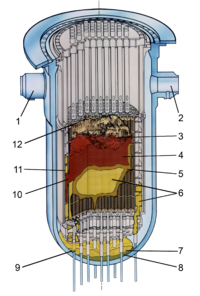
Photo from wikipedia
Abstract During core meltdown accidents, the heat flux distribution along the wall of lower plenum was closely related to the potential of vessel failure. Concerning with the natural convection heat… Click to show full abstract
Abstract During core meltdown accidents, the heat flux distribution along the wall of lower plenum was closely related to the potential of vessel failure. Concerning with the natural convection heat transfer behavior in stratified corium pools, several two-layer tests were performed on COPRA facility recently. The test vessel (a 1/4 circular slice with an inner radius of 2.2 m and a width of 0.2 m) is divided into two parts by a plate made of 304 stainless steel. The lower part, heated by 18 electrical heating rods, is applied to simulate the oxide pool. The upper part without heat generation is assumed to be a metallic layer. During the experiment, different heating powers and boundary conditions were employed to obtain the temperature distributions of oxide pool and metal layer, as well as the heat flux through the vessel wall. Prototypic Ra′ range, varied from 1.88 × 1016 to 5.39 × 1016, was successfully achieved in the oxide pool. Despite the smaller downward Nudn numbers, the upward Nuup numbers within this study were well in accordance with the reported data. It should be mentioned that the results of water are unrepresentative for the reactor situation since no crust was formed in the bottom and top of oxide pool. However, the current study will still attract interest by the qualitative analysis of top cooling influence on natural convection phenomenon and provide valuable information to other researchers who concern with the crust formation and focusing effect on stratified corium pools behavior.
Journal Title: Nuclear Engineering and Design
Year Published: 2019
Link to full text (if available)
Share on Social Media: Sign Up to like & get
recommendations!